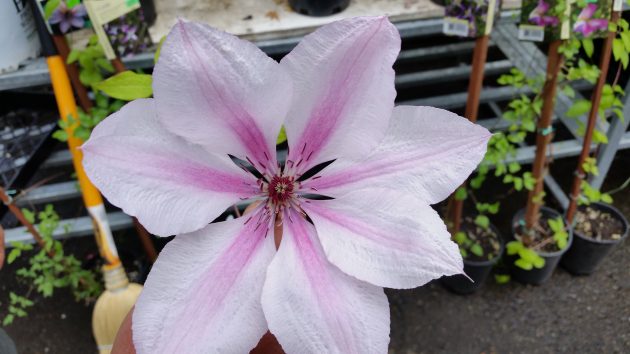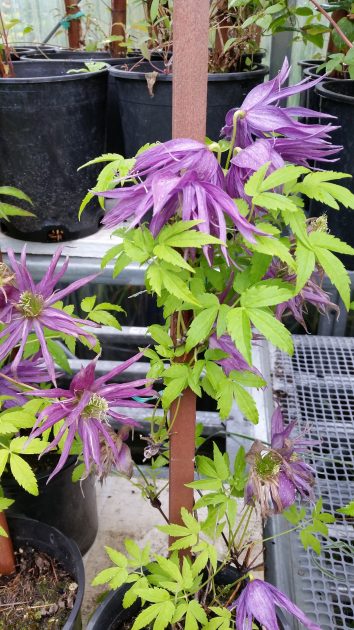Queen of the Vines – Clematis
One of the most beautiful flowering vines, for our area, is the Clematis.
This attractive, deciduous, hardy, perennial vine is ideal for those vertical areas, or to creep along a fence, arbor or wall.
There are many different varieties with a choice of flowers that come in a wide range of colour, shape, size (2.5-25 cm), and bloom times. Even when not in bloom the vines are attractive, as the finished flowers form fluffy seed clusters that can last for weeks, giving the vine a different appearance. Clematis vines come in differing heights ranging from 9 meters to 3 meters, with most varieties ranging around 5 meters.
Clematis grows well in our area, if they are grown in the right location. Clematis roots need cool moist soil, deep root depth, and moisture, while the leaves and stem enjoys 6 hours of full daily sun. To keep the roots cool, while the vine enjoys the sun place a good layer of mulch around the base of the plant or by planting a low growing perennial at the base of the plant.
For the best success a clematis should be planted correctly. They need a deep root depth so start by digging a large hole, 45 cm wide and deep. Cover the bottom of the hole with a rich compost, then a good quality topsoil mixed with bonemeal. Before taking the clematis out of the container give it a thorough water and then gently take the plant out of the container making sure that the root ball remains intact as you don’t want to disturb the roots. Place the clematis in the hole so that the top of the root ball is 15 cm below the soil line. Fill the hole with soil so that it is even with the top of the root ball, then towards the end of the season, when the stem of the plant is ‘ripe’, the remaining soil can be added to fill the hole.
By planting the clematis deep, you are giving it added winter protection as well as giving the plant a chance to grow back from below ground level if it is attacked by a fungus called ‘clematis wilt’ (ascochyta clematidina) . Once planted, give the plant a thorough water, and continue to water regularly as they do not tolerate drought well, but be careful not to overwater either. Add a trellis and/or netting to assist the plant to climb up on.
When purchasing your clematis hang on to the tag as this will indicate the care it needs when it comes to pruning. Clematis are divided into three basic groups. A-B-C.
“A” type clematis are early bloomers and bloom on last season’s growth. These require very little pruning and only after they have finished blooming. Only remove any weak or dead stems.
“B” type Clematis varieties bloom on both last season’s growth and on new growth. Group B can be broken down even further, into group B1 which produces one heavy flush of flowers followed by a smaller flush later in the season. Group B2 continually blooms throughout the season. Group B varieties are pruned lightly in May with some variation in the length of the stems to create an even shaped plant, and then the branches are spaced, to make room for next year’s flowers.
“C” type clematis varieties are the hardiest and these bloom continually as they bloom only on new (this season’s growth). Prune these in May, as you want to promote lots of new growth, which will produce lots of flowers. Prune these back to 2 strong sets of buds per stem from ground level. If they are left unpruned the plant will become unruly, and there will only be flowers where the new growth starts.
Considered the ‘Queen of the Vines’ clematis is a beautiful addition to any landscape!
-Jos
Jos Van Hage pwns and operates two Art Knapp Home and Garden Centres in Prince George:
- Highway 16 West at Kimball Road
- Highway 97 North at Northwood Pulpmill road



Comments
Comments for this article are closed.